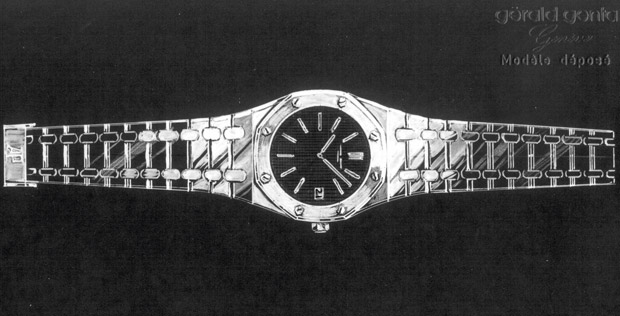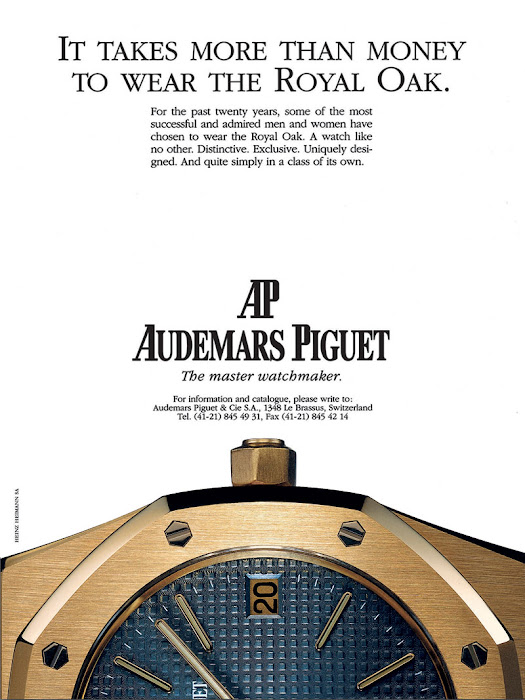Crafted by Audemars Piguet, this iconic timepiece has not only set the standard for luxury sports watches but has also become a symbol of the brand's relentless pursuit of excellence and innovation.
Key Takeaways:
-
Innovation: Faced with the quartz crisis, Audemars Piguet innovated by creating the Royal Oak, a luxury steel watch that broke traditional norms and redefined luxury watchmaking standards.
-
Design: Gerald Genta's groundbreaking design of the Royal Oak, with its distinctive octagonal bezel and integrated bracelet, established a new era in watch aesthetics and luxury, emphasizing craftsmanship over precious materials.
-
Legacy: Over fifty years since its inception, the Royal Oak continues to evolve, embracing both tradition and innovation and remains a cornerstone of Audemars Piguet's offerings.
The Start of the Royal Oak in the Quartz Crisis
Rewinding to the start of the 1970s, Audemars Piguet, alongside Swiss watchmakers, found itself in a bad situation. The influx of Japanese quartz watches sparked what is famously known as "the quartz crisis," impacted the Swiss watchmaking industry with a dramatic downturn in sales.
In 1971, facing the threat of financial ruin without significant innovation, Audemars Piguet responded to feedback from the Italian market indicating a potential interest in a steel luxury watch. This led the company's decision-makers to pursue the creation of a completely novel concept: a sporty yet sophisticated timepiece unlike anything seen before.

The task of designing this groundbreaking watch fell to Gerald Genta, a renowned watch designer born in Geneva in 1931 to an Italian father and a Swiss mother. Genta, already famous for his work with Universal Genève, Omega, and Patek Philippe, was approached by Audemars Piguet's managing director at the time, Georges Golay.
On the eve of the 1971 Basel Fair, Golay reached out to Genta with a challenging request: to design an “unprecedented steel watch” by the next morning, one that could cater to all occasions with elegance and finish.
Genta rose to the occasion, and by the following morning, he had conceptualized the watch that would later be known as the Royal Oak. Genta would eventually regard the Royal Oak as the crowning achievement of his illustrious career.
Crafting the Initial Royal Oak
Interestingly, the journey of the Royal Oak began with its first prototypes crafted in white gold instead of stainless steel. This choice was due to the complex and costly process of machining high-grade steel to meet Genta's precise specifications, making white gold a more practical option for these early versions.
The heart of the Royal Oak was the crafted self-winding Calibre 2121, which continues to power the Royal Oak Jumbo today. This movement evolved from the Audemars Piguet Calibre 2120, distinguished by the addition of a date complication.
The Origins of Calibre 2120
The Calibre 2120, introduced in 1967, was born from a collaborative effort led by Jaeger-LeCoultre, with significant contributions from Audemars Piguet and financial support from both Audemars Piguet and other prestigious brands like Patek Philippe and Vacheron Constantin. This partnership aimed to develop an ultra-thin automatic movement, culminating in the creation of the Jaeger-LeCoultre Calibre 920. This innovative movement was then personalized by each of the three funding brands—serving as the foundation for the Patek Philippe 28-255 C in the Nautilus and the Vacheron Constantin 1120 in their 222 model.

With an overall height of just 3.05 mm and a vibration frequency of 19,800 per hour, the Calibre 2121 featured an anti-shock system that made it perfectly suited for a sports watch like the Royal Oak.
Nautical Inspiration and Naming
Gerald Genta's inspiration for the Royal Oak's design came from a diver's brass helmet, which is reflected in its maritime-themed name. "Royal Oak" was chosen in honor of the historic British Royal Navy vessels, sharing their name with the legendary oak tree that provided refuge to King Charles II of England during the English Civil War. This connection to heritage and resilience is symbolized in the octagonal bezel of the watch, mirroring the eight vessels named Royal Oak.
In 1972, the stage was set at the Basel Fair for the unveiling of the Royal Oak, marking a significant milestone in the world of luxury watchmaking.
Launching the Royal Oak

Marketed at 3300 Swiss Francs, the Royal Oak's debut was nothing short of revolutionary. This unprecedented stainless steel timepiece was priced higher than a gold Patek Philippe dress watch and was over ten times the cost of a Rolex Submariner. Such a bold pricing strategy underscored a new philosophy in horlogerie: that luxury timepieces could transcend the traditional reliance on precious metals, focusing instead on design, execution precision, and movement quality.

Initial Reception and Critical Acclaim
Despite its groundbreaking introduction, the Royal Oak did not enjoy instant success. It faced considerable scrutiny for its disruptive design, which included a visible gasket, exposed screws, and an integrated bracelet, not to mention its steep price tag. Critics were quick to predict the downfall of Audemars Piguet, believing that such a departure from traditional luxury watch aesthetics would lead to the company's bankruptcy.
However, the unique appeal and exceptional quality of the Royal Oak gradually won over watch collectors and fashion-forward individuals. With its distinct design and craftsmanship, it began to draw a knowledgeable and discerning audience, eventually securing the Royal Oak's position as a major success for Audemars Piguet and a hallmark of the brand's identity.
Establishing a Legacy with the A-Series
In response to the growing interest, Audemars Piguet produced the first series of 1000 pieces, now revered by collectors as the A-series of reference 5402. Although it took over a year to sell the initial batch of Royal Oaks, this slow start eventually gave way to increasing demand. Following the A-series, the company continued with A serial numbers for another 1000 pieces before transitioning to B and C serial numbers.
Today, the first Royal Oak A-series remains among the most coveted by collectors, easily recognized by the placement of the AP initials above the 6 o'clock position, unlike in later series. This early edition not only symbolizes the birth of a new era in luxury watchmaking but also represents the resilience and innovation of Audemars Piguet, proving that visionary design and exceptional craftsmanship can redefine the standards of luxury horology.
The Royal Oak Through Time
In the years following its groundbreaking debut, Audemars Piguet continued to evolve the Royal Oak collection, incorporating precious metals, leather and rubber straps, and unveiling new technical innovations and complications.
The Evolution of Complexity and Style
-
Royal Oak Perpetual Calendar (1981): Audemars Piguet set a new standard in 1981 with the Royal Oak Perpetual Calendar Calibre 2120/2800, becoming the world’s thinnest perpetual calendar watch of its time. This model featured a mechanical memory that could accurately track calendar variations, including leap years, without needing manual adjustment until 2100.

-
Royal Oak Day/Date Moonphase (1984): With a white dial showcasing secondary dials for day and date, alongside a moon-phase display, this model offered an exquisite alternative to the perpetual calendar movement, underlining the brand’s expertise in combining functionality with elegance.
Daring to Innovate: The Royal Oak Offshore and Concept Series
-
Royal Oak Offshore (1993): To celebrate the 20th anniversary of the Royal Oak, Audemars Piguet introduced the Royal Oak Offshore, designed by Emmanuel Gueit. Aimed at sports enthusiasts and the youth, the Offshore featured a deconstructed design, revealing the watch's architecture and its key elements, such as the prominent black gasket on the bezel. Its launch size of 42 mm was considered massive at the time, earning it the nickname "The Beast."

-
Royal Oak Concept (2002): The 30th anniversary of the Royal Oak was marked by the introduction of the Royal Oak Concept, a testament to absolute performance through technical sophistication and durability. This series was notable for utilizing alacrite 602, an exceptionally hard superalloy from the aeronautical industry.
Recent Milestones: Embracing Tradition and Innovation
-
Royal Oak Equation of Time (2010): This model combined four high complications: a perpetual calendar, a lunar cycle display, the equation of time, and civil sunrise and sunset times, showcasing Audemars Piguet’s mastery over complex horological functions.
-
Royal Oak "Jumbo" Extra-Thin (2012 and 2022): The 40th and 50th anniversaries of the Royal Oak were commemorated with the release of updated "Jumbo" Extra-Thin models, further refining the original design with modern mechanical advancements. The 2022 version introduced the Calibre 7121, offering enhanced power reserve and an innovative winding mechanism, along with aesthetic modifications to accentuate its iconic design.

The Royal Oak Today:
Despite numerous iterations and advancements, the "Jumbo" models, particularly the ref. 15202 and its successor ref. 16202, remains the quintessence of the Royal Oak's appeal.
These versions stay true to the originals, featuring a sapphire exhibition back that allows owners to admire the intricate movement within. With the Royal Oak's legacy continuing to flourish more than 50 years after its beginning, its enduring appeal is a testament to Audemars Piguet's commitment to innovation and craftsmanship.
Conclusion:
The Royal Oak born out of necessity during the quartz crisis, shattered conventions with its daring steel construction and distinctive design, charting a new course for luxury timepieces.
Gerald Genta's visionary design, coupled with Audemars Piguet's commitment to craftsmanship and innovation, propelled the Royal Oak into watchmaking history. Through the decades, the collection has evolved, embracing new technologies and designs while maintaining the essence of its original draw.
Learn more and get a piece of history today at G&G Timpeices!




